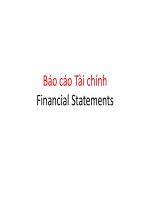Introduc corporate finance ch12
Bạn đang xem bản rút gọn của tài liệu. Xem và tải ngay bản đầy đủ của tài liệu tại đây (158.34 KB, 38 trang )
Risk, Cost of Capital and Capital
Budgeting
Chapter
12
12.1 The Cost of Equity Capital
12.2 Estimation of Beta
12.3 Determinants of Beta
12.4 Extensions of the Basic Model
12.5 Estimating International Paper’s Cost of
Capital
12.6 Reducing the Cost of Capital
12.7 Summary and Conclusions
What’s the Big Idea?
Earlier chapters on capital budgeting
focused on the appropriate size and
timing of cash flows.
This chapter discusses the appropriate
discount rate when cash flows are risky.
The Cost of Equity Capital
Firm with
excess cash
Pay cash dividend
Shareholder
invests in
financial
asset
A firm with excess cash can either pay a
dividend or make a capital investment
Invest in project
Shareholder’s
Terminal
Value
Because stockholders can reinvest the dividend in risky financial assets, the
expected return on a capital-budgeting project should be at least as great as the
expected return on a financial asset of comparable risk.
The Cost of Equity
From the firm’s perspective, the expected
return is the Cost of Equity Capital:
R i = RF + βi ( R M − RF )
• To estimate a firm’s cost of equity capital, we need
to know three things:
1. The risk-free rate, RF
− RF
Cov ( Ri , RM ) σ i , M
= 2
3. The company beta, βi =
Var ( RM )
σM
2. The market risk premium, R M
Example
Suppose the stock of Stansfield Enterprises, a
publisher of PowerPoint presentations, has a beta of
2.5. The firm is 100-percent equity financed.
Assume a risk-free rate of 5-percent and a market risk
premium of 10-percent.
What is the appropriate discount rate for an expansion
of this firm?
R = RF + βi ( R M − RF )
R = 5% + 2.5 ×10%
R = 30%
Example (continued)
Suppose Stansfield Enterprises is evaluating the
following non-mutually exclusive projects. Each costs
$100 and lasts one year.
Project
Project β
A
IRR
NPV at
30%
2.5
Project’s
Estimated Cash
Flows Next
Year
$150
50%
$15.38
B
2.5
$130
30%
$0
C
2.5
$110
10%
-$15.38
IRR
Project
Using the SML to Estimate the RiskAdjusted Discount Rate for Projects
Good
A
projects
30%
B
5%
C
SML
Bad projects
Firm’s risk (beta)
2.5
An all-equity firm should accept a project whose IRR exceeds the cost of
equity capital and reject projects whose IRRs fall short of the cost of capital.
Estimation of Beta: Measuring
Market Risk
Market Portfolio - Portfolio of all assets in
the economy. In practice a broad stock
market index, such as the S&P
Composite, is used to represent the
market.
Beta - Sensitivity of a stock’s return to the
return on the market portfolio.
Estimation of Beta
Theoretically, the calculation of beta is
straightforward:
2
i ,M
2
M
Cov ( Ri , RM ) σ
β=
=
Var ( RM )
σ
Beta Estimation, continued.
Problems
Betas may vary over time.
The sample size may be inadequate.
Betas are influenced by changing financial leverage and
business risk.
Solutions
Problems 1 and 2 (above) can be moderated by more
sophisticated statistical techniques.
Problem 3 can be lessened by adjusting for changes in
business and financial risk.
Look at average beta estimates of comparable firms in the
industry.
Stability of Beta
Most analysts argue that betas are
generally stable for firms remaining in the
same industry.
That’s not to say that a firm’s beta can’t
change.
Changes in product line
Changes in technology
Deregulation
Changes in financial leverage
Using an Industry Beta
It is frequently argued that one can better estimate
a firm’s beta by involving the whole industry.
If you believe that the operations of the firm are
similar to the operations of the rest of the industry
- use the industry beta.
If you believe that the operations of the firm are
fundamentally different from the operations of the
rest of the industry -use the firm’s beta.
Don’t forget about adjustments for financial
leverage.
Determinants of Beta
Business Risk
Cyclicity of Revenues
Operating Leverage
Financial Risk
Financial Leverage
Cyclicality of Revenues
Highly cyclical stocks have high betas.
Empirical evidence suggests that retailers and
automotive firms fluctuate with the business cycle.
Transportation firms and utilities are less dependent
upon the business cycle.
Note that cyclicality is not the same as
variability—stocks with high standard
deviations need not have high betas.
Movie studios have revenues that are variable,
depending upon whether they produce “hits” or
“flops”, but their revenues are not especially
dependent upon the business cycle.
Operating Leverage
The degree of operating leverage measures how
sensitive a firm (or project) is to its fixed costs.
Operating leverage increases as fixed costs rise
and variable costs fall.
Operating leverage magnifies the effect of
cyclicity on beta.
The degree of operating leverage is given by:
Change in EBIT
Sales
DOL =
×
EBIT
Change in Sales
Operating Leverage
$
Total
costs
Fixed costs
∆ EBIT
∆ Volume
Fixed costs
Volume
Operating leverage increases as fixed costs rise
and variable costs fall.
Financial Leverage and Beta
Operating leverage refers to the sensitivity to the
firm’s fixed costs of production.
Financial leverage is the sensitivity of a firm’s fixed
costs of financing.
The relationship between the betas of the firm’s
debt, equity, and assets is given by:
β Asset
Debt
Equity
=
× β Debt +
× β Equity
Debt + Equity
Debt + Equity
• Financial leverage always increases the equity beta
relative to the asset beta.
Financial Leverage and Beta:
Example
Consider Grand Sport, Inc., which is currently allequity and has a beta of 0.90. The firm has
decided to lever up to a capital structure of 1
part debt to 1 part equity. Since the firm will
remain in the same industry, its asset beta
should remain 0.90. However, assuming a zero
beta for its debt, its equity beta would become
twice as large:
βEquity
Debt
= 0.90 × 1 + 1 = 1.80
= βAsset × 1 +
Equity
1
Extensions of the Basic Model
The Firm versus the Project
The Cost of Capital with Debt
The Firm versus the Project
Any project’s cost of capital depends on
the use to which the capital is being put
—not the source.
Therefore, it depends on the risk of the
project and not the risk of the company.
Project
IRR
Capital Budgeting & Project
Risk
The SML can tell us why:
SML
Incorrectly accepted
negative NPV projects
RF + βFIRM ( R M − RF )
Hurdle
rate
rf
βFIRM
Incorrectly rejected
positive NPV projects
Firm’s risk (beta)
A firm that uses one discount rate for all projects may over time
increase the risk of the firm while decreasing its value.
Capital Budgeting & Project
Risk
Suppose the Conglomerate Company has a cost of capital, based
on the CAPM, of 17%. The risk-free rate is 4%; the market risk
premium is 10% and the firm’s beta is 1.3.
17% = 4% + 1.3 × [14% – 4%]
This is a breakdown of the company’s investment projects:
1/3 Automotive retailer β = 2.0
1/3 Computer Hard Drive Mfr. β = 1.3
1/3 Electric Utility β = 0.6
average β of assets =
1.3
When evaluating a new electrical generation investment, which cost of
capital should be used?
SML
IRR
Project
Capital Budgeting & Project
Risk
24%
Investments in hard
drives or auto retailing
should have higher
discount rates.
17%
10%
Firm’s risk (beta)
0.6
1.3
2.0
r = 4% + 0.6×(14% – 4% ) = 10%
10% reflects the opportunity cost of capital on an investment in
electrical generation, given the unique risk of the project.
The Cost of Capital with Debt
The Weighted Average Cost of Capital is given by:
rWACC
S
B
=
× rS +
× rB × (1 − TC )
S+B
S+B
• Since interest expense is tax-deductible, we
multiply the last term by (1- TC)
Estimating International
Paper’s Cost of Capital
First, we estimate the cost of equity and
the cost of debt.
We estimate an equity beta to estimate the
cost of equity.
We can often estimate the cost of debt by
observing the YTM of the firm’s debt.
Second, we determine the WACC by
weighting these two costs appropriately.









